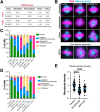This is a preprint.
Functional genetics reveals modulators of anti-microtubule drug sensitivity
- PMID: 38559203
- PMCID: PMC10979949
- DOI: 10.1101/2024.03.12.584469
Functional genetics reveals modulators of anti-microtubule drug sensitivity
Update in
-
Functional genetics reveals modulators of antimicrotubule drug sensitivity.J Cell Biol. 2025 Feb 3;224(2):e202403065. doi: 10.1083/jcb.202403065. Epub 2024 Nov 21. J Cell Biol. 2025. PMID: 39570287 Free PMC article.
Abstract
Microtubules play essential roles in diverse cellular processes and are important pharmacological targets for treating human disease. Here, we sought to identify cellular factors that modulate the sensitivity of cells to anti-microtubule drugs. We conducted a genome-wide CRISPR/Cas9-based functional genetics screen in human cells treated with the microtubule-destabilizing drug nocodazole or the microtubule-stabilizing drug taxol. We further conducted a focused secondary screen to test drug sensitivity for ~1400 gene targets across two distinct human cell lines and to additionally test sensitivity to the Kif11-inhibitor, STLC. These screens defined gene targets whose loss enhances or suppresses sensitivity to anti-microtubule drugs. In addition to gene targets whose loss sensitized cells to multiple compounds, we observed cases of differential sensitivity to specific compounds and differing requirements between cell lines. Our downstream molecular analysis further revealed additional roles for established microtubule-associated proteins and identified new players in microtubule function.
Keywords: Microtubule; dynamic instability; mitosis; nocodazole; taxol.
Figures





References
-
- Adelmann C.H., Wang T., Sabatini D.M., and Lander E.S.. 2019. Genome-Wide CRISPR/Cas9 Screening for Identification of Cancer Genes in Cell Lines. Methods Mol Biol. 1907:125–136. - PubMed
-
- Akhmanova A., and Steinmetz M.O.. 2008. Tracking the ends: a dynamic protein network controls the fate of microtubule tips. Nat Rev Mol Cell Biol. 9:309–322. - PubMed
-
- Akhmanova A., and Steinmetz M.O.. 2015. Control of microtubule organization and dynamics: two ends in the limelight. Nat Rev Mol Cell Biol. 16:711–726. - PubMed
-
- Arnal I., and Wade R.H.. 1995. How does taxol stabilize microtubules? Curr Biol. 5:900–908. - PubMed
Publication types
Grants and funding
LinkOut - more resources
Full Text Sources
Research Materials
